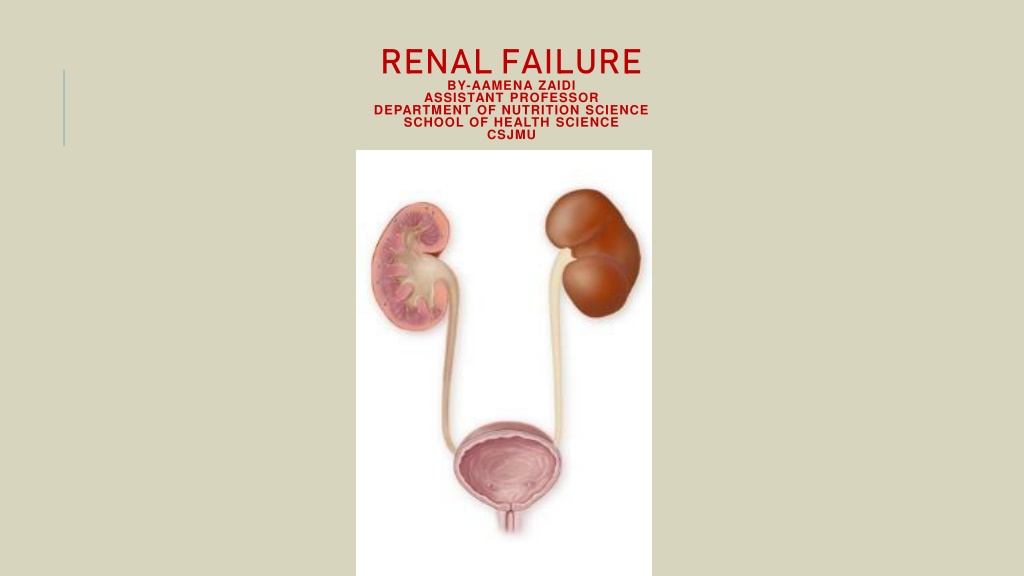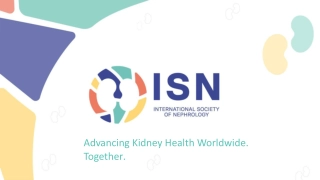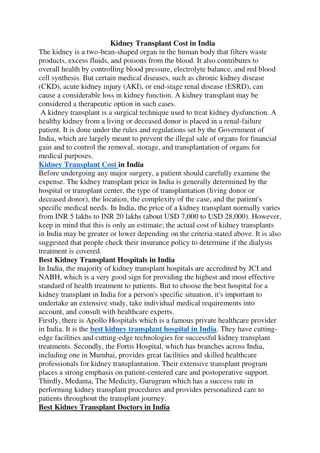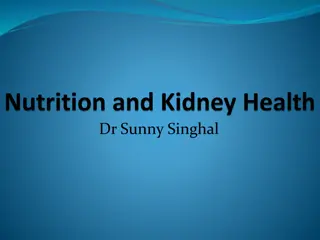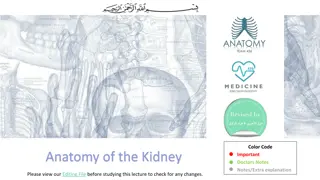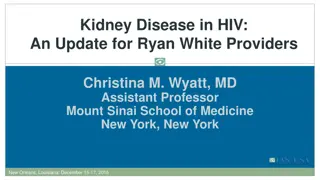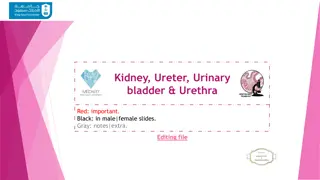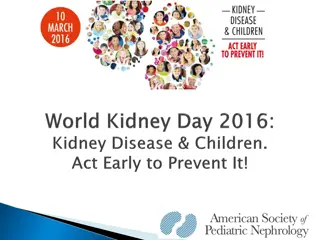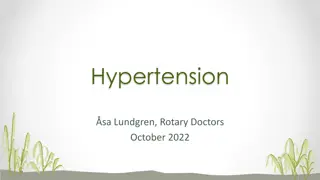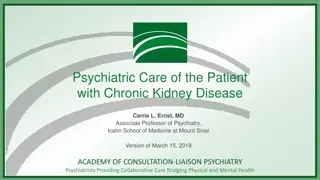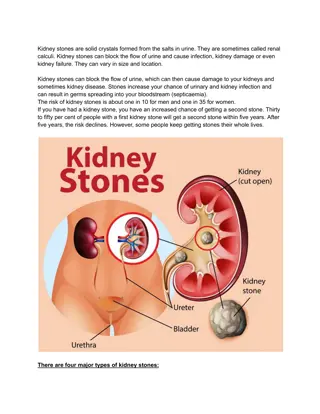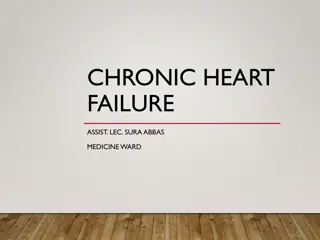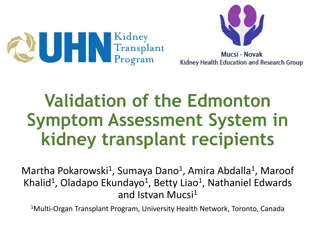Understanding Kidney Failure: Causes, Symptoms, and Treatment Options
Kidney failure can be temporary or chronic, affecting the body's ability to eliminate toxins. Common causes include diabetes and high blood pressure. Recognizing symptoms early and managing conditions like diabetes can prevent kidney failure. Treatment options such as dialysis and kidney transplant can help individuals with limited kidney function lead fulfilling lives.
Download Presentation

Please find below an Image/Link to download the presentation.
The content on the website is provided AS IS for your information and personal use only. It may not be sold, licensed, or shared on other websites without obtaining consent from the author. Download presentation by click this link. If you encounter any issues during the download, it is possible that the publisher has removed the file from their server.
E N D
Presentation Transcript
RENAL FAILURE BY-AAMENA ZAIDI ASSISTANT PROFESSOR DEPARTMENT OF NUTRITION SCIENCE SCHOOL OF HEALTH SCIENCE CSJMU
What is kidney/renal failure? Means one or both kidneys can no longer function well on their own. Sometimes, kidney failure is temporary (Acute) and other times, it is a chronic condition that can get worse slowly over a long time. Kidney failure may sound serious, and it is. But treatments such as dialysis and kidney transplant help many people with limited kidney function continue to live fulfilling lives.
FUNCTIONS OF KIDNEY One of the most important is helping our body eliminate toxins. The kidneys filter our blood and send waste out of our body in urine. When the kidneys don t work effectively, waste products build up in our body. If this happens, one might feel sick. In the most serious situations, kidney failure can be life-threatening. However, many people can manage kidney failure with the right treatment.
SYMPTOMS AND CAUSES The most common causes of kidney failure are diabetes and high blood pressure. Sometimes, though, kidney failure happens quickly due to an unforeseen cause. When the kidneys lose function suddenly (within hours or days), it s called acute kidney failure (or acute kidney injury). This type of kidney failure is often temporary. Common causes of acute kidney failure can include: Autoimmune kidney diseases Certain medications Severe dehydration A urinary tract obstruction Uncontrolled systemic disease like heart or liver disease
Chronic kidney disease refers to a group of health conditions that affect how well our kidneys function over time. If left untreated, chronic kidney disease can lead to kidney failure. The biggest causes of kidney failure from chronic kidney disease are: Diabetes: Unmanaged diabetes can lead to uncontrolled blood sugar levels. Consistently high blood sugar can damage the body s organs, including the kidneys. High blood pressure: High blood pressure (hypertension) means blood travels through our body s blood vessels with increased force. Over time, untreated high blood pressure levels can damage the kidney tissue.
Other causes of chronic kidney disease include: Polycystic kidney disease, a hereditary condition where cysts (fluid-filled sacs) grow inside our kidneys. Glomerular diseases, such as glomerulonephritis. Other autoimmune diseases that can affect multiple body systems.
SYMPTOMS In early stages of kidney disease, many people experience few or no symptoms. It s important to note that chronic kidney disease can still cause damage. Chronic kidney disease and kidney failure can cause different symptoms for different people.
If your kidneys arent working properly, one may notice one or more of the following signs: Fatigue (extreme tiredness) An upset stomach or vomiting Confusion or trouble concentrating Swelling, especially around our hands or ankles Muscle spasms (muscle cramps) Dry or itchy skin Poor appetite or metallic taste of food
DIAGNOSIS Blood tests, which can show how well the kidneys are removing waste from the blood. Advanced imaging, which can show kidney abnormalities or obstructions (blockages). Urine tests, which measure the amount of urine or specific substances in the urine, such as protein or blood.
MANAGEMENT AND TREATMENT Kidney failure treatment is determined by the cause and extent of the problem. Treating our chronic medical condition can delay the progression of kidney disease. If our kidneys start losing their function gradually, doctor may use one or more methods to track like: Routine blood tests Blood pressure checks Medication
MANAGEMENT OF CHRONIC RENAL FAILURE The causes of CRF are progression of acute nephritis or nephrosis, renal calculi, polycystic kidneys, nephropathy, diabetes and gout. The urine volume depends upon GFR. Manefestations of CRF are General: Dehydration or water intoxication, sodium depletion, hyperkalemia, acidosis, increased susceptibility to infection CVD: oedema of lungs and ankle, hypertension, arrhythmias Gastro intestinal: anorexia, vomiting, hicoughs Neurological: peripheral neuropathy, convulsions, coma Haempoietic system: Anaemia
Skin: Pigmentation, Skeletal: Renal dystrophy (Renal Osteodystrophy is a form of metabolic bone disease seen in patients with chronic renal insufficiency characterized by bone mineralization deficiency due to electrolyte and endocrine abnormalities. Patients present with osteomalacia, osteonecrosis and pathologic fractures) due to the inability of the damaged kidney to convert vitamin D3 to calcitrol (the active form), metastatic calcification and dwarfism.
PLASMA CREATININE Normal value- 1.4 mg/100 ml (Males) Normal value- 1.3 mg/100 ml (Females) Creatinine is completely excreted by glomeruli. GFR from plasma creatinine is calculated as: GFR (Men)=92/plasma creatinine GFR (Women)=70/plasma creatinine
DIETETIC MANAGEMENT ENERGY 35-50 Kcal/kg/bwt/day is supplied mainly from carbohydrates and fats for protein sparing effect. Poor energy intakes are common in chronic renal failure due to anorexia, altered taste acuity, frequent illnesses and hospitalisations and dietary restrictions. Energy needs are at least equal to the recommended dietary intake. Supplementary nutrition in the form of oral supplements or enteral feeding is often needed.
Increasing energy intakes through supplementation enhances the efficiency of protein utilisation and improves nitrogen balance. It is useful to aim for 50 % of energy from carbohydrates and 20-30% as fat . A combination of fat and carbohydrate as a supplement is less likely to produce elevated triglyceride levels.
PROTEIN Restriction of protein intake has been proposed as a means of limiting excessive hyperfiltration, thereby reducing progressive glomerulosclerosis and subsequent deterioration of renal function. Restricting protein severely also restricts intakes of other important nutrients such as calcium, iron and zinc. In CRF 40 gm protein is permitted, but when the GFR is below 10 ml per min, marked protein restriction is necessary. When GFR falls below 4 ml per min, a 20 gm protein diet must be insisted.
FATS The serum TG level are raised partly due to excessive carbohydrate feeding. For energy, fats with carbohydrates are recommended in uraemic patients. CARBOHYDRATES They provide the main source of energy to reduce endogenous protein breakdown. Sugars and Cereals are liberally permitted. Vegetables and fruits should be suitably processed to decrease the potassium content.
FLUIDS Requirements for fluid depend on the aetiology of the renal disease and the level of the GFR. When limitations are needed because of oedema or hypertension the amount is based on the insensible water losses plus measured urine output. In early stages of CRF, there is loss of ability to concentrate urine, therefore the patient is allowed liberal fluids. With progressive kidney failure, GFR and urine volume diminish. This results in oedema and hyponatraemia necessitating fluid restriction.
SODIUM Initial treatment should be a dietary salt restriction followed by medication. Sodium depletion occurs a the kidney lose their power of conserving sodium. Sodium restriction is detrimental because hyponatraemia and volume contraction will aggravate the ongoing renal insufficiency. Sodium restriction is a difficult aspect of nutritional management because of the wide availability and consumption of high salt snack and fast foods. The allowance depends on the presence of oedema, hypertension, aetiology of the renal disorder and the administration of sodium containing medications
POTASSIUM For most patients hyperkalaemia is usually not a problem until in end stage renal failure when urine production is reduced. Hyperkalemia results from tissue breakdown releasing potassium and scanty urine decreasing urinary potassium excretion. A combination of hyperlalemia, hypocalcaemia and hypermagesiumia produces adverse myocardial effects exhibiting ECG changes. Potassium intake of foods must be reduced. Vegetables and Potatoes are rich in potassium. Their potassium content can be considerably reduced by slicing and rinsing in running water, subsequently placing them in a temperature of 50-60 degree C for 2 hours and again rinsing in running water.
CALCIUM AND VITAMIN D In advanced renal failure the diminished capacity of the kidney to synthesize active vitamin D leads to hypocalcaemia and secondary hyperparathyroidism. Calcium supplements are indicated for two reasons, firstly to increase the calcium available for absorption from the gut and secondly to bind phosphate in the gastro-intestinal tract. Calcitriol, the active form of Vitamin D, is given to stimulate calcium absorption from the gut and normalise the body's calcium phosphate balance.
17 FOODS TO AVOID OR LIMIT 1. Dark-coloured soda In addition to the calories and sugar that sodas provide, they harbour additives that contain phosphorus, especially dark-coloured sodas. Many food and beverage manufacturers add phosphorus during processing to enhance flavour, prolong shelf life, and prevent discoloration. Sodas, especially those that are dark, should be avoided on a renal diet.
2. Avocados Avocados are known for their many nutritious qualities, including their heart-healthy fats, fiber, and antioxidants. While avocados are usually a healthy addition to the diet, those with kidney disease may need to avoid them. This is because avocados are a very rich source of potassium. One average-sized avocado provides a 690 mg of potassium
3. Canned foods Canned foods such as soups, vegetables, and beans contain high amounts of sodium, as salt is added as a preservative to increase its shelf life. Due to the amount of sodium found in canned goods, it s often recommended that people with kidney disease avoid or limit their consumption.
4. Whole wheat bread Choosing the right bread can be confusing for individuals with kidney disease. Often for healthy individuals, whole wheat bread is usually not recommended over refined, white flour bread. Whole wheat bread may be a more nutritious choice, mostly due to its higher fiber content. However, white bread is usually recommended over whole wheat varieties for individuals with kidney disease.
This is because of its phosphorus and potassium content. The more bran and whole grains in the bread, the higher the phosphorus and potassium contents. White bread is typically recommended over whole wheat bread on a renal diet due to its lower phosphorus and potassium levels. All bread contains sodium, so it s best to compare food labels and choose a lower sodium variety.
5. Brown rice Like whole wheat bread, brown rice is a whole grain that has a higher potassium and phosphorus content. One cup of cooked brown rice contains 150 mg of phosphorus and 154 mg of potassium, while 1 cup of cooked white rice contains only 69 mg of phosphorus and 54 mg of potassium. Bulgur, buckwheat, pearled barley, are nutritious, lower phosphorus grains that can make a good substitute for brown rice.
6. Bananas Bananas are known for their high potassium content. While they re naturally low in sodium, 1 medium banana provides 422 mg of potassium. Many other tropical fruits have high potassium contents as well. However, pineapples contain substantially less potassium than other tropical fruits and can be a more suitable yet tasty alternative.
7. Dairy Dairy products are rich in various vitamins and nutrients. They re also a natural source of phosphorus and potassium and a good source of protein. 1 cup (240 mL) of whole milk provides 222 mg of phosphorus and 349 mg of potassium. Yet, consuming too much dairy can be detrimental to bone health in those with kidney disease.
Dairy products are also high in protein. One cup (240 mL) of whole milk provides about 8 grams of protein. It may be important to limit dairy intake to avoid the build up of protein waste in the blood. Dairy products contain high amounts of phosphorus, potassium, and protein and should be limited on a renal diet. Despite milk s high calcium content, its phosphorus content may weaken bones in those with kidney disease.
8. Oranges and orange juice While oranges and orange juice are most well known for their vitamin C content, they re also rich sources of potassium. One large orange provides 333 mg of potassium. Moreover, there are 473 mg of potassium in 1 cup (240 mL) of orange juice. Given their potassium content, oranges and orange juice likely need to be avoided or limited on a renal diet. Grapes, apples, and cranberries, as well as their respective juices, are all good substitutes for oranges and orange juice, as they have lower potassium contents.
9. Processed meats Processed meats have long been associated with chronic diseases and are generally considered unhealthy due to their preservative contents. Processed meats are meats that have been salted, dried, cured, or canned. Processed meats typically contain large amounts of salt, mostly to improve their taste and preserve flavour. Therefore, it may be difficult to keep our daily sodium intake to less than 2,300 mg if processed meats are abundant in our diet. Additionally, processed meats are high in protein. It s important to limit processed meats for this reason.
10. Pickles, olives Usually, large amounts of salt are added during the curing or pickling process. Processed olives also tend to be salty, as they re cured and fermented to taste less bitter. Pickles, processed olives, are high in sodium and should be limited on a renal diet.
11.Apricots Apricots are rich in vitamin C, vitamin A, and fiber. They re also high in potassium. One cup of fresh apricots provides 427 mg of potassium. Furthermore, the potassium content is even more concentrated in dried apricot, over 1,500 mg of potassium. It s best to avoid apricots, and most importantly dried apricots.
12. Potatoes and sweet potatoes Potatoes and sweet potatoes are potassium-rich vegetables. Just one medium-sized baked potato contains 610 mg of potassium, whereas one average- sized baked sweet potato contains 541 mg of potassium. Fortunately, some high potassium foods, including potatoes and sweet potatoes, can be soaked or leached to reduce their potassium contents. Cutting potatoes into small, thin pieces and boiling them for at least 10 minutes can reduce the potassium content by about 50%. Potatoes that are soaked in water for at least 4 hours before cooking are proven to have an even lower potassium content than those not soaked before cooking.
This method is known as potassium leaching or the double-cook method. Although double cooking potatoes lowers the potassium content, it s important to remember that their potassium content isn t eliminated by this method. Considerable amounts of potassium can still be present in double-cooked potatoes, so it s best to practice portion control to keep potassium levels in check.
13. Tomatoes Tomatoes are high in potassium that may not fit the guidelines of a renal diet. Just 1 cup of tomato sauce can contain upwards of 900 mg of potassium .
14. Packaged, instant, and premade meals Processed foods can be a major component of sodium in the diet. Among these foods, packaged, instant, and premade meals are usually the most heavily processed and thus contain the most sodium. Examples include frozen pizza, microwaveable meals, and instant noodles. Keeping sodium intake to 2,300 mg per day may be difficult if eating highly processed foods regularly. Heavily processed foods not only contain a large amount of sodium but also commonly lack nutrients. It s best to limit these foods on a renal diet.
15. Spinach, and beet greens Spinach, and beet greens are leafy green vegetables that contain high amounts of various nutrients and minerals, including potassium. When served raw, the amount of potassium varies between 140 290 mg per cup. While leafy vegetables shrink to a smaller serving size when cooked, the potassium content remains the same. For example, one-half cup of raw spinach will shrink to about 1 tablespoon when cooked. Thus, eating one-half cup of cooked spinach will contain a much higher amount of potassium than one-half cup of raw spinach.
However, moderate the intake of these foods, as theyre also high in oxalates. Among sensitive individuals, oxalates can increase the risk of kidney stones. Kidney stones may further damage renal tissue and decrease kidney function.
16. Dates, raisins, and prunes Dates, raisins, and prunes are common dried fruits. When fruits are dried, all of their nutrients are concentrated, including potassium. For example, 1 cup of prunes provides 1,274 mg of potassium, which is nearly 5 times the amount of potassium found in 1 cup of plums, its raw counterpart. Moreover, just 4 dates provide 668 mg of potassium. Given the high amount of potassium in these common dried fruits, it s best to go without them while on a renal diet to ensure potassium levels remain favourable.
17. Chips, and crackers Ready-to-eat snack foods like chips, and crackers tend to be lacking in nutrients and relatively high in salt. Also, it s easy to eat more than the recommended portion size of these foods, often leading to even greater salt intake than intended. If chips are made from potatoes, they ll contain a significant amount of potassium as well.
The bottom line If one is having kidney disease, reducing potassium, phosphorus, and sodium intake can be an important aspect of managing the disease. The high sodium, high potassium, and high phosphorus foods are likely best limited or avoided. Dietary restrictions and nutrient intake recommendations will vary based on the severity of your kidney damage. Following a renal diet can seem daunting and a bit restrictive at times. However, working with a healthcare professional and renal dietitian can help design a renal diet specific to individual needs.
Because the kidneys serve such an important purpose, people in kidney failure need treatment to keep them alive. The main treatments for kidney failure are: Dialysis: This treatment helps the body filter the blood (doing the job that the kidneys can no longer perform). In hemodialysis, a machine regularly cleans your blood for you. People often receive this kidney failure treatment at a hospital or dialysis clinic, 3 or 4 days each week. Peritoneal dialysis cleans the blood in a slightly different way using a dialysis solution and a catheter. Sometimes, people can do their treatment at home.
Kidney transplant: In kidney transplant surgery, doctors place a healthy kidney in your body to take over the job of your damaged organs. This healthy kidney, called a donor organ, may come from a deceased donor or a living donor, who may be a friend or family member. People can live well with one healthy kidney.
PREVENTION Can kidney failure be prevented? While kidney failure from chronic kidney disease can t be reversed, you can do many things to help preserve the kidney function you have today. Healthy habits and routines may slow down how quickly kidneys lose their functional abilities. If you have chronic kidney disease or kidney failure, you ll want to: Monitor your kidney function, with your doctor s help. Keep your blood sugar levels under control, if you have diabetes. Keep your blood pressure levels in a normal range. Avoid smoking. Make healthy diet choices, such as limiting foods high in protein and sodium.
